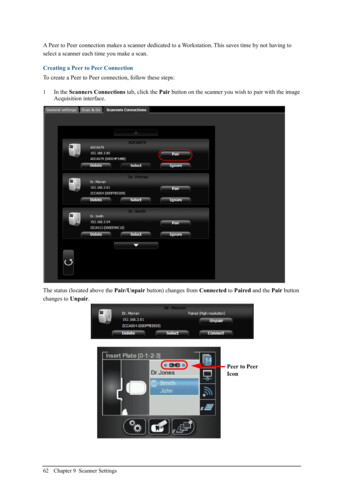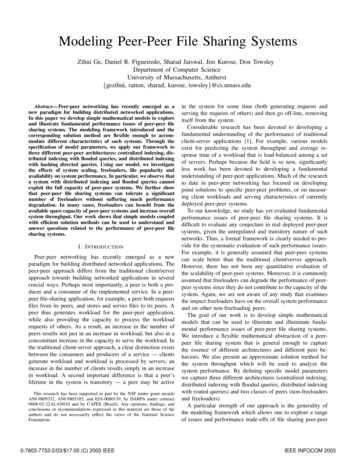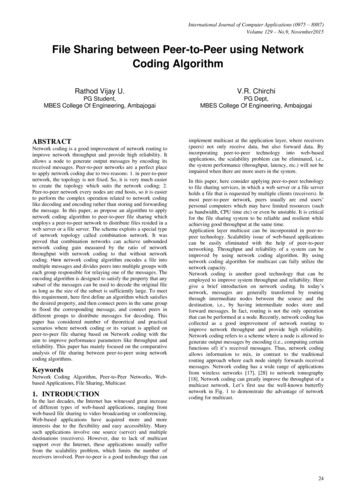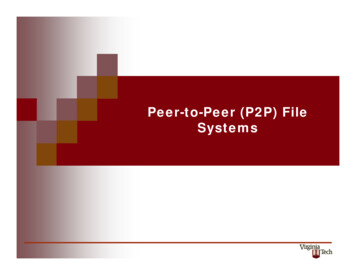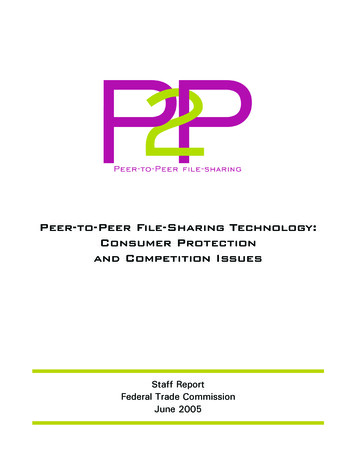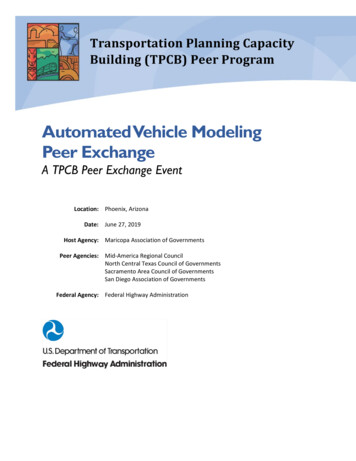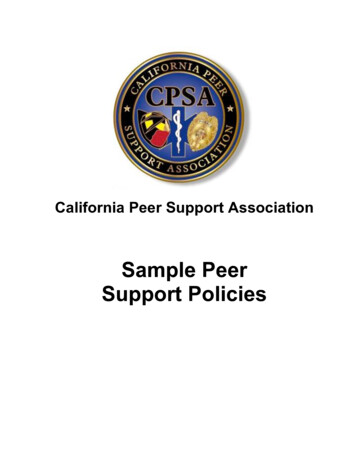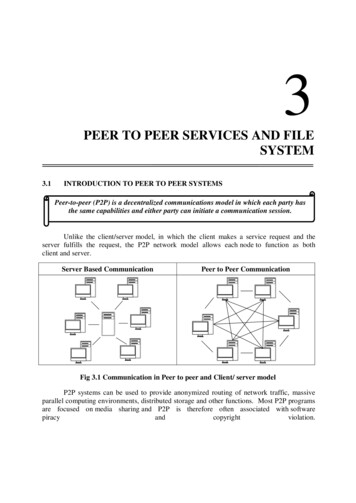
Transcription
3PEER TO PEER SERVICES AND FILESYSTEM3.1INTRODUCTION TO PEER TO PEER SYSTEMSPeer-to-peer (P2P) is a decentralized communications model in which each party hasthe same capabilities and either party can initiate a communication session.Unlike the client/server model, in which the client makes a service request and theserver fulfills the request, the P2P network model allows each node to function as bothclient and server.Server Based CommunicationPeer to Peer CommunicationFig 3.1 Communication in Peer to peer and Client/ server modelP2P systems can be used to provide anonymized routing of network traffic, massiveparallel computing environments, distributed storage and other functions. Most P2P programsare focused on media sharing and P2P is therefore often associated with softwarepiracyandcopyrightviolation.
3.2Peer to Peer Services and File SystemFeatures of Peer to Peer Systems Large scale sharing of data and resources No need for centralized management Their design of P2P system must be in such a manner that each user contributesresources to the entire system. All the nodes in apeer-to-peer system have the same functional capabilities andresponsibilities. The operation of P2P system does not depend on the centralized management. The choice of an algorithm for theplacement of data across many hosts and theaccess of the data must balance the workload and ensure the availability withoutmuch overhead.Advantages of P2P systems over client/ server architecture1) It is easy to install and so is the configuration of computers on the network.2) All the resources and contents are shared by all the peers, unlike server-clientarchitecture where Server shares all the contents and resources.3) P2P is more reliable as central dependency is eliminated. Failure of one peerdoesn‟t affect the functioning of other peers. In case of Client –Server network, ifserver goes down whole network gets affected.4) There is no need for full-time System Administrator. Every user is theadministrator of his machine. User can control their shared resources.5) The over-all cost of building and maintaining this type of network is comparativelyvery less.Disadvantages of P2P systems over client/ server architecture1) In this network, the whole system is decentralized thus it is difficult to administer.That is one person cannot determine the whole accessibility setting of wholenetwork.2) Security in this system is very less viruses, spywares,trojans, etc malwares caneasily transmitted this architecture.3) Data recovery or backup is very difficult. Each computer should have its ownback-up system4) Lot of movies, music and other copyrighted files are transferred using this type offiletransfer.P2Pisthetechnologyusedintorrents.
Distributed System3.3P2P Middleware Middleware is the software that manages and supports the different components ofa distributed system. In essence, it sits in the middle of the system. Middleware is usually off Middleware is usually off-the-shelf rather than speciallywritten software. A key problem in Peer-to-Peer applications is to provide a way for clients to accessdata resources efficiently. Peer clients need to locate and communicate with any available resource, eventhough resources may be widely distributed and configuration may be dynamic,constantly adding and removing resources and connections. The P2P middleware must possess the following characteristics: Global Scalability Load Balancing Local Optimization Adjusting to dynamic host availability Security of data Anonymity, deniability, and resistance to censorship3.1.1 Routing OverlaysA routing overlay is a distributed algorithm for a middleware layer responsiblefor routing requests from any client to a host that holds the object to which therequest is addressed. Any node can access any object by routing each request through a sequence ofnodes, exploiting knowledge at each of theme to locate the destination object. Global User IDs (GUID) also known as opaque identifiers are used as names, butthey do not contain the location information. A client wishing to invoke an operation on an object submits a request includingthe object‟s GUID to the routing overlay, which routes the request to a node atwhichareplicaoftheobjectresides.
3.4Peer to Peer Services and File SystemFig 3.2: Information distribution in Routing OverlayDifferences between Overlay networks and IP routingIPOverlay NetworkThe scalability of IPV4 is limited to 232 Peer to peer systems can address morenodes and IPv6 is 2128.objects using GUID.The load balancing is done based on Traffic patterns are independent oftopology.topology since the object locations ed Routing tables are updatedsynchronously and synchronously.bothFailure of one node does not degrade the Routes and object references can beperformance much. Redundancy is replicated n-fold, ensuring toleranceintroduced in IP. n-fold replication is of n failures of nodes or connections.costly.Each IP can map to only one node.Secure addressing isbetween trusted nodes.possibleMessages are routed to the nearest replicaof the target object.only Secure communication is possiblebetween limited trusted systems.
Distributed System3.5Distributed Computation3.2 Distributed computing refers to multiple computer systems working on a singleproblem. Here a single problem is divided into many parts, and each part is solved bydifferent computers. As long as the computers are networked, they can communicate with each other tosolve the problem. The computers perform like a single entity. The ultimate goal of distributed computation is to maximize performance byconnecting users and IT resources in a cost-effective, transparent and reliablemanner. It also ensures fault tolerance and enables resource accessibility in the event thatone of the components fails.NAPSTER AND ITS LEGACY APPLICATION The Internet was originally built as a peer-to-peer system in the late 1960s toshare computing resources within the US. Later the transfer of resources between systems took place by means of clientserver communication. Later Napster was developed for peer –to-peer file sharing especially MP3 files. They are not fully peer-to-peer since it used central servers to maintain lists ofconnected systems and the files they provided, while actual transactions wereconducted directly between machines.3.2.1 Working of Napster Each user must have Napster software in order to engage in file transfers. The user runs the Napster program. Once executed, this program checks for anInternet connection. If an Internet connection is detected, another connection between the user'scomputer and one of Napster's Central Servers will be established. This connectionis made possible by the Napster file-sharing software. The Napster Central Server keeps a directory of all client computers connected toitandstoresinformationonthemasdescribedabove.
3.6Peer to Peer Services and File System If a user wants a certain file, they place a request to the Napster Centralised Serverthat it's connected to. The Napster Server looks up its directory to see if it has any matches for the user'srequest. The Server then sends the user a list of all that matches (if any) it as foundincluding the corresponding, IP address, user name, file size, ping number, bit rateetc. The user chooses the file it wishes to download from the list of matches and triesto establish a direct connection with the computer upon which the desired fileresides. It tries to make this connection by sending a message to the client computerindicating their own IP address and the file name they want to download from theclient. If a connection is made, the client computer where the desired file resides is nowconsidered the host. The host now transfers the file to the user. The host computer breaks the connection with the user computer whendownloading is complete.peersNapster serverIndex1. File locationrequestNapster serverIndex2. List of peersof f ering the f ile5. Index update4. File deliv eredFig 3.1: NapsterLimitations of Napster:Discovery and addressing a file is difficult unless the location is distributed.
Distributed System3.33.7PEER TO PEER MIDDLEWARE Middleware is the software that manages and supports the different componentsof a distributed system. In essence, it sits in the middle of the system. Middleware is usually off Middleware is usually off-the-shelf rather thanspecially written software. A key problem in Peer-to-Peer applications is to provide a way for clients toaccess data resources efficiently. Peer clients need to locate and communicate with any available resource, eventhough resources may be widely distributed and configuration may be dynamic,constantly adding and removing resources and connections. The following are the functional requirements of the middleware: Simplify construction of services across many hosts in wide network Add and remove resources at will Add and remove new hosts at will Interface to application programmers should be simple and independentof types of distributed resources The following are the non functionalrequirements of the middleware: Global Scalability Load Balancing Optimization for local interactions between neighboring peers Accommodation to highly dynamic host availability Security of data in an environment simplify construction ofservices across many hosts in wide network Anonymity, deniability and resistance to censorship Sharing and balancing across large numbers of computers pose major designchallenges to the development of middleware. In order to locate an object, the knowledge of object location must be distributedthroughoutnetworkthroughreplication.
3.8Peer to Peer Services and File System3.4ROUTING OVERLAYA routing overlay is a distributed algorithm for a middleware layer responsible forrouting requests from any client to a host that holds the object to which the requestis addressed. Any node can access any object by routing each request through a sequence ofnodes, exploiting knowledge at each of theme to locate the destination object. Global User IDs (GUID) also known as opaque identifiers are used as names, butthey do not contain the location information. A client wishing to invoke an operation on an object submits a request includingthe object‟s GUID to the routing overlay, which routes the request to a node atwhich a replica of the object resides. They are actually sub-systems within the peer-to-peer middleware that are meantlocating nodes and objects. They implement a routing mechanism in the application layer. They ensure that any node can access any object by routing each request thru asequence of nodesFeatures of GUID: They are pure names or opaque identifiers that do not reveal anything about thelocations of the objects. They are the building blocks for routing overlays. They are computed from all or part of the state of the object using a function thatdeliver a value that is very likely to be unique. Uniqueness is then checked againstall other GUIDs. They are not human understandable.Process of Routing Overlay Client submits a request including the object GUID, routing overlay routes therequest to a node at which a replica of the object resides. A node introduces a new object by computing its GUID and announces it to therouting overlay. Note that clients can remove an object and also nodes may join and leave theservice
Distributed System3.9Types of Routing Overlays1. DHT – Distributed Hash Tables. GUIDs are stored based on hash values.2. DOLR – Distributed Object Location and Routing. DOLR is a layer over the DHTthat maps GUIDs and address of nodes. GUIDs host address is notified using thePublish() operation.3.5PASTRYPastry is a generic, scalable and efficient substrate for peer-to-peer applications.Pastry nodes form a decentralized, self-organizing and fault-tolerant overlaynetwork within the Internet. Pastry provides efficient request routing, deterministic object location, and loadbalancing in an application-independent manner. Furthermore, Pastry provides mechanisms that support and facilitate applicationspecific object replication, caching, and fault recovery. Each node in the Pastry network has a unique, uniform random identifier (nodeId) ina circular 128-bit identifier space. When presented with a message and a numeric 128-bit key, a Pastry node efficientlyroutes the message to the node with a nodeId that is numerically closest to the key,among all currently live Pastry nodes. The expected number of forwarding steps in the Pastry overlay network is O(log N),while the size of the routing table maintained in each Pastry node is only O(log N) insize (where N is the number of live Pastry nodes in the overlay network). At each Pastry node along the route that a message takes, the application is notifiedand may perform application-specific computations related to the message. Each Pastry node keeps track of its L immediateneighbors in the nodeId space calledthe leaf set, and notifies applications of new node arrivals, node failures and noderecoveries within the leaf set. Pastry takes into account locality (proximity) in the underlying Internet. It seeks to minimize the distance messages travel, according to a scalar proximitymetric like the ping delay. Pastry is completely decentralized, scalable, and self-organizing; it eofnodes.
3.10Peer to Peer Services and File SystemCapabilities of Pastry Mapping application objects to Pastry nodes Application-specific objects are assigned unique, uniform random identifiers(objIds) and mapped to the k, (k 1) nodes with nodeIds numerically closestto the objId. The number k reflects the application's desired degree of replication for theobject. Inserting objects Application-specific objects can be inserted by routing a Pastry message, usingthe objId as the key. When the message reaches a node with one of the k closest nodeIds to theobjId, that node replicates the object among the other k-1 nodes with closestnodeIds (which are, by definition, in the same leaf set for k L/2). Accessing objects Application-specific objects can be looked up, contacted, or retrieved byrouting a Pastry message, using the objId as the key. By definition, the message is guaranteed to reach a node that maintains areplica of the requested object unless all k nodes with nodeIds closest to theobjId have failed. Availability and persistence Applications interested in availability and persistence of application-specificobjects maintain the following invariant as nodes join, fail and recover: objectreplicas are maintained on the k nodes with numerically closest nodeIds to theobjId, for k 1. The fact that Pastry maintains leaf sets and notifies applications of changes inthe set's membership simplifies the task of maintaining this invariant. Diversity The assignment of nodeIds is uniform random, and cannot be corrupted by anattacker. Thus, with high probability, nodes with adjacent nodeIds are diversein geographic location, ownership, jurisdiction, network attachment, etc. The probability that such a set of nodes is conspiring or suffers from correlatedfailures is low even for modest set sizes. This minimizes the probability of a simultaneous failure of all k nodes thatmaintainanobjectreplica.
Distributed System3.11 Load balancing Both nodeIds and objIds are randomly assigned and uniformly distributed inthe 128-bit Pastry identifier space. Without requiring any global coordination, this results in a good first-orderbalance of storage requirements and query load among the Pastry nodes, aswell as network load in the underlying Internet. Object caching Applications can cache objects on the Pastry nodes encountered along thepaths taken by insert and lookup messages. Subsequent lookup requests whose paths intersect are served the cached copy. Pastry's network locality properties make it likely that messages routed withthe same key from nearby nodes converge early, thus lookups are likely tointercept nearby cached objects. This distributed caching offloads the k nodes that hold the primary replicas ofan object, and it minimizes client delays and network traffic by dynamicallycaching copies near interested clients. Efficient, scalable information dissemination Applications can perform efficient multicast using reverse path forwarding alongthe tree formed by the routes from clients to the node with nodeId numericallyclosest to a given objId. Pastry's network locality properties ensure that the resulting multicast trees areefficient; i.e., they result in efficient data delivery and resource usage in theunderlying Internet.3.5.1 Pastry’s Routing AlgorithmThe routing algorithm involves the use of a routing table at each node to routemessages efficiently. This is divided into two stages: First Stage: In this stage a routing scheme is used, that routes messages correctly butinefficiently without a routing table. Each active node stores a leaf set – a vector L (of size 2l) containing theGUIDs and IP addresses of the nodes whose GUIDs are numerically closest oneithersideofitsown(laboveandlbelow).
3.12Peer to Peer Services and File System Leaf sets are maintained by Pastry as nodes join and leave. Even after a nodefailure, they will be corrected within a short time. In the Pastry system that the leaf sets reflect a recent state of the system andthat they converge on the current state in the face of failures up to somemaximum rate of failure. The GUID space is treated in circular fashion. GUID 0‟s lower neighbour is 2128–1. Every leaf set includes the GUIDs and IP addresses of the current node‟simmediateneighbours. A Pastry system with correct leaf sets of size at least 2 can route messages toany GUID trivially as follows: any node A that receives a messageM withdestination address D routes the message by comparing D with its own GUIDAand with each of the GUIDs in its leaf set and forwarding M to the nodeamongstthem that is numerically closest to D. Second Stage: This has a full routing algorithm, which routes a request to any nodein O(log N) messages. Each Pastry node maintains a tree-structured routing table with GUIDs andIP addresses for a set of nodes spread throughout the entire range of 2128possible GUID values, with increased density of coverage for GUIDsnumerically close to its own. The structure of routing table is: GUIDs are viewed as hexadecimal values andthe table classifies GUIDs based on their hexadecimal prefixes. The table has as many rows asthere are hexadecimal di gits in a GUID, so forthe prototype Pastry system that weare describing, there are 128/4 32 rows. Any row n contains 15 entries – one foreach possible value of the nthhexadecimal digit, excluding the value in the local node ‟s GUID. Each entry in the table points to one of the potentially many nodeswhose GUIDs have the relevant prefix. The routing process at any node A uses the information in its routing table Rand leaf set L to handle each request from an application and each thm.
Distributed System3.13Pastry’s Routing AlgorithmTo handle a message M addressed to a node D (where R[p,i] is the element at column i,row p of the routing table):1. If (L-l D Ll) { // the destination is within the leaf set or is the current node.2. Forward M to the element Li of the leaf set with GUID closest to D or thecurrent node A.3. } else { // use the routing table to despatch M to a node with a closer GUID4. Find p, the length of the longest common prefix ofD and A,.and i, the (p 1)thhexadecimal digit of D.5. If (R[p,i] null) forward M to R[p,i] // route M to a node with a longer common prefix.6. else { // there is no entry in the routing table.7. Forward M to any node in L or R with a common prefix of length p but aGUID that is numerically closer.}}Locality The Pastry routing structure is redundant. Each row in a routin g table contains 16 entries. The entries in the ithrow give the addresses of 16 nodes with GUIDs with i–1 initialhexadecimal digits thatmatch the current node ‟s GUID and an ith di git that takes eachof the possible hexadecimal mal values. A well-populated Pastry overlay will contain many more nodesthan can be containedin an individual routing table; whenever a new routing table isbeing constructed achoice is made for each position between several candidates based on a proximityneighbour selection algorithm. A locality metric is used to compare candidates and the closest available node ischosen. Since the information available is not comprehensive, this mechanism cannotproduce globally optimal routings, but simulations have shown that it results in routesthat are on average only about 30–50% longer than the optimum.
3.14Peer to Peer Services and File SystemFault tolerance The Pastry routing algorithm assumes that allentries in routing tables and leaf setsrefer to live, correctly functioning nodes. All nodessend „heartbeat‟ messages i.e., messages sent at fixed time intervals toindicate that thesender is alive to neighbouring nodes in their leaf sets, butinformation about failednodes detected in this manner may not be disseminatedsufficiently rapidly to eliminaterouting errors. Nor does it account for malicious nodes that may attempt to interfere withcorrect routing. To overcome these problems, clients that depend upon reliable messagedeliveryare expected to employ an at-least-once delivery mechanism and repeat theirrequests several times in the absence of a response. This willallow Pastry a longer time window to detect and repair node failures. To deal with any remaining failures or malicious nodes, a small degree ofrandomness is introduced into the route selection algorithm.Dependability Dependability measures include the use of acknowledgements at each hop in therouting algorithm. If the sending host does not receive an acknowledgement after aspecified timeout,it selects an alternative route and retransmits the message. The nodethat failed to send an acknowledgement is then noted as a suspectedfailure. To detect failed nodes each Pastry node periodically sends aheartbeat message toits immediate neighbour to the left (i.e., with a lower GUID) in theleaf set. Each node also records the time of the last heartbeat message received from itsimmediate neighbour on the right (with a higher GUID). If the interval since the lastheartbeat exceeds a timeout threshold, the detectingnode starts a repair procedure thatinvolves contacting the remaining nodes in theleaf set with a notification about thefailed node and a request for suggestedreplacements. Even in the case of multiplesimultaneous failures, this procedure terminates withall nodes on the left side of thefailed node having leaf sets that contain the l livenodeswiththeclosestGUIDs.
Distributed System3.15 Suspectedfailed nodes in routing tables are probed in a similar manner to that usedfor the leaf setand if they fail to respond, their routing table entries are replacedwith a suitablealternative obtained from a nearby node. A simple gossip protocol is used to periodically exchange routing tableinformation betweennodes in order to repair failed entries and prevent slowdeterioration of the localityproperties. The gossip protocol is run about every 20 minutes.3.6TAPESTRY Tapestry is a decentralized distributed system. It is an overlay network that implements simple key-based routing. Each node serves as both an object store and a router that applications can contactto obtain objects. In a Tapestry network, objects are “published” at nodes, and once an object hasbeen successfully published, it is possible for any other node in the network to findthe location at which that objects is published. Identifiers are either NodeIds, which refer to computers that perform routingoperations, or GUIDs, which refer to the objects. For any resource with GUID G there is a unique root node with GUID RG that isnumerically closest to G. Hosts H holding replicas of G periodically invoke publish(G) to ensure that newlyarrived hosts become aware of the existence of FE79157ECFig 3.4: Tapestry RoutingAA934378Phil‟sBooks
3.16Peer to Peer Services and File SystemUnstructured peer-to-peer Networks In structured approaches, there is an overall global policy governing the topologyof the network, the placement of objects in the network and the routing or searchfunctions used to locate objects in the network. There is a specific data structure underpinning the associated overlay and a set ofalgorithms operating over that data structure. These algorithms are efficient and time bounded. In unstructured approaches, there is no overall control over the topology or theplacement of objects within the network. The overlay iscreated in an ad hoc manner, with each node that joins the networkfollowing simple, local rules to establish connectivity. In particular, a joining node will establishcontact with a set of neighboursknowing that the neighbours will also be connected tofurtherneighbours and so on,forming a network that is fundamentally decentralized andself-organizing g andhence resilient to node failure. To locate a given object, it is thennecessary to carry out a search of the resultantnetwork topology. This approachcannot offer guarantees of being able to find the object andperformance will beunpredictable. There is a real risk of generating excessive message traffic tolocate objects.Differences between structured and unstructured networksStructured NetworkUnstructured NetworkThis guarantees to locate objects and can This is self-organizing and resilient tooffer time and complexity bounds on this node failure.operation. So it has relatively low messageoverhead.This needs complexoverlay structures, whichcan bedifficult and costly to abilistic and hence cannot offerabsolute guarantees on locating objects;prone to excessive messaging overheadwhich can affect scalabilityGnutella The Gnutella network is a fully decentralized, peer-to-peer application layernetwork that facilitates file sharing; and is built around an open protocol developedto enable host discovery, distributed search, and file transfer.
Distributed System3.17 It consists of the collection of Internet connected hosts on which Gnutella protocolenabled applications are running. The Gnutella protocol makes possible all host-to-host communication through theuse of messages.Fig : 3.5: Message Format A message consists of the following five fields: The GUID field provides a unique identifier for a message on the network; theType field indicates which type of message is being communicated. TTL field enumerates the maximum number of hops that this message isallowed to traverse. Hops field provides a count of the hops already traversed. Payload Size field provides a byte count of all data expected to follow themessage. A host communicates with its peers by receiving, processing, and forwardingmessages, but to do so it must follow a set of rules which help to ensurereasonable message lifetimes. The rules are as follows:1. Prior to forwarding a message, a host will decrement its TTL field andincrement its Hops field. If the TTL field is found to be zero following thisaction, the message is not forwarded.2. If a host encounters a message with the same GUID and Type fields as amessage already forwarded, the new message is treated as a duplicate and isnot forwarded a second time.Types of MessageThere are only five types of messages Ping Pong Query
3.18Peer to Peer Services and File System Query-Hit PushPing and Pong messages facilitate host discovery, Query and Query-Hit messages makepossible searching the network, and Push messages ease file transfer from firewalledhosts.Because there is no central index providing a list of hosts connected to the network, adisconnected host must have offline knowledge of a connected host in order to connect to thenetwork. Once connected to the network, a host is always involved in discovering hosts,establishing connections, and propagating messages that it receives from its peers,but it may also initiate any of the following six voluntary activities: searching forcontent, responding to searches, retrieving content, and distributing content. A hostwill typically engage in these activities simultaneously. A host will search for other hosts and establish connections so as to satisfy amaximum requirement for active connections as specified by the user, or to replaceactive connections dropped by it or its peer. Consequently, a host tends to always maintain the maximum requirement foractive connections as specified by the user, or the one connection that it needs toremain connected to the network. To engage in host discovery, a host must issue a Ping message to the host of whichit has offline knowledge. That host will then forward the ping message across its open connections, andoptionally respond to it with a Pong message. Each host that subsequently receives the Ping message will act in a similar manneruntil the TTL of the message has been exhausted. A Pong message may only be routed along the reverse of the path that carried thePing message to which it is responding. After having discovered a number of other hosts, the host that issued the initialping message may begin to open further connections to the network. Doing so allows the host to issue ping messages to a wider range of hosts andtherefore discover a wider range of other hosts, as well as to begin querying thenetwork. In searching for content, a host propagates search queries across its activeconnections. Those queries are then processed and forwarded by its peers.
Distributed System3.19 When proc
The Internet was originally built as a peer-to-peer system in the late 1960s to share computing resources within the US. Later the transfer of resources between systems took place by means of client server communication. Later Napster was developed for peer -to-peer file sharing especially MP3 files.
